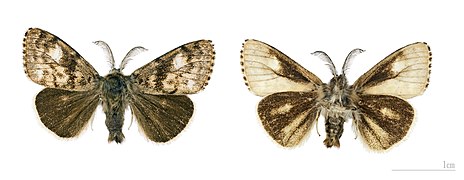bio.wikisort.org - Animal
Gynaephora selenitica is a moth in the family Erebidae first described by Eugenius Johann Christoph Esper in 1789.[1] It is found from central Europe through eastern Europe to the Urals. It is not found in western and southern Europe and Scandinavia.[2]
| Gynaephora selenitica | |
|---|---|
 | |
| Scientific classification | |
| Kingdom: | Animalia |
| Phylum: | Arthropoda |
| Class: | Insecta |
| Order: | Lepidoptera |
| Superfamily: | Noctuoidea |
| Family: | Erebidae |
| Genus: | Gynaephora |
| Species: | G. selenitica |
| Binomial name | |
| Gynaephora selenitica (Esper, 1789) | |
| Synonyms | |
| |
The wingspan is 20–25 mm for males and 30–35 mm for females. Adults are on wing from May to June.
The larvae are polyphagous and feed mainly on Fabaceae species (including Lotus, Coronilla, Hippocrepis and Onobrychis), as well as various shrubs (Prunus spinosa, Salix, Vaccinium, Calluna and Rosa) and other plants (Asteraceae, Rosaceae including Potentilla). Larvae can be found from July to April. The species overwinters in the larval stage.[3]
- Caterpillar
- Female
- Male
References
- Savela, Markku (July 2, 2019). "Gynaephora selenitica (Esper, 1789)". Lepidoptera and Some Other Life Forms. Retrieved March 27, 2020.
- "Gynaephora selenitica (Esper, 1789)". Fauna Europaea. Retrieved March 27, 2020.
- Schmetterlinge und ihre Ökologie (in German)
External links
Wikimedia Commons has media related to Gynaephora selenitica.
- "10394 Gynaephora selenitica (Esper, 1789) - Mondfleck-Bürstenspinner, Mondfleck-Bürstenbinder". Lepiforum e. V.
На других языках
- [en] Gynaephora selenitica
[fr] Gynaephora selenitica
Gynaephora selenitica, le Bombyx sélénitique ou Orgyie sélénitique, est une espèce de lépidoptères (papillons) de la famille des Erebidae et de la sous-famille des Lymantriinae.[ru] Шерстолапка лунчатая
Шерстолапка лунчатая или Волнянка лунчатая (лат. Gynaephora selenitica) — бабочка из семейства волнянок (Lymantriidae). Локальный и нечастый лесо-луговой ксеромезофильный вид.Текст в блоке "Читать" взят с сайта "Википедия" и доступен по лицензии Creative Commons Attribution-ShareAlike; в отдельных случаях могут действовать дополнительные условия.
Другой контент может иметь иную лицензию. Перед использованием материалов сайта WikiSort.org внимательно изучите правила лицензирования конкретных элементов наполнения сайта.
Другой контент может иметь иную лицензию. Перед использованием материалов сайта WikiSort.org внимательно изучите правила лицензирования конкретных элементов наполнения сайта.
2019-2025
WikiSort.org - проект по пересортировке и дополнению контента Википедии
WikiSort.org - проект по пересортировке и дополнению контента Википедии


